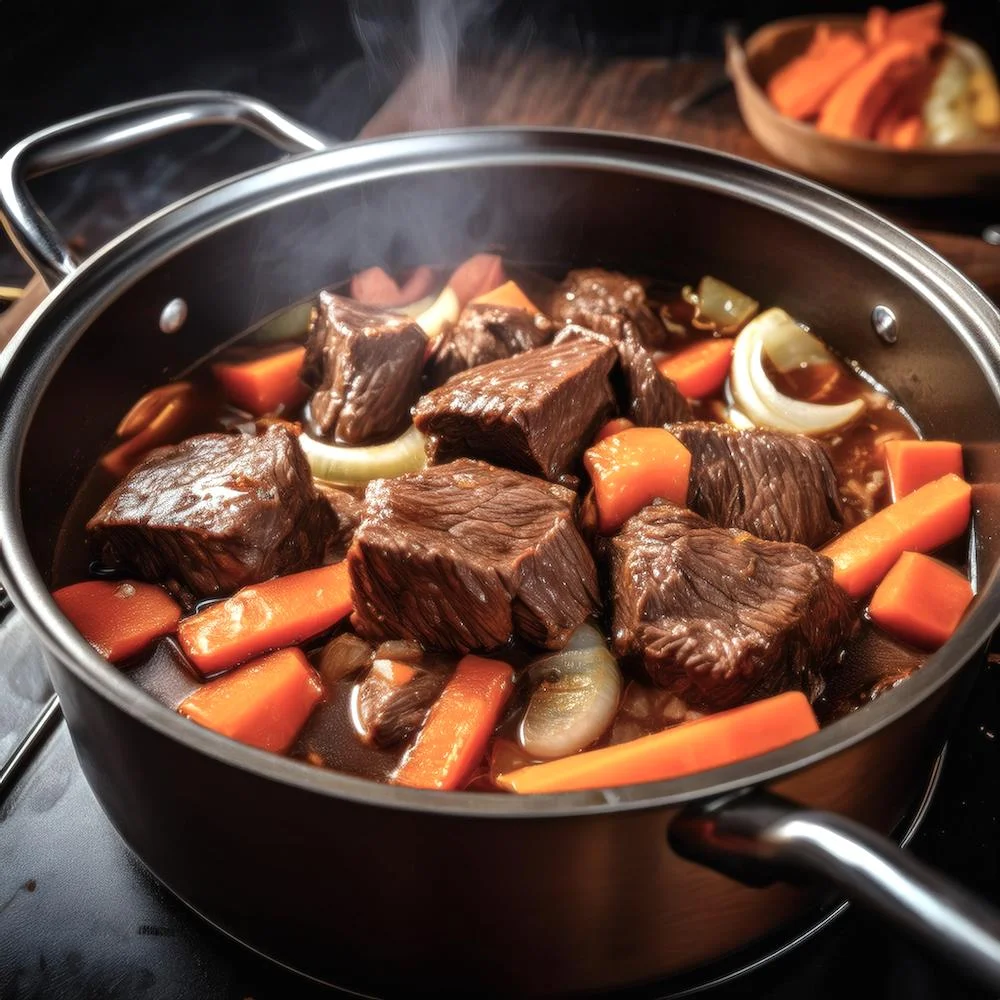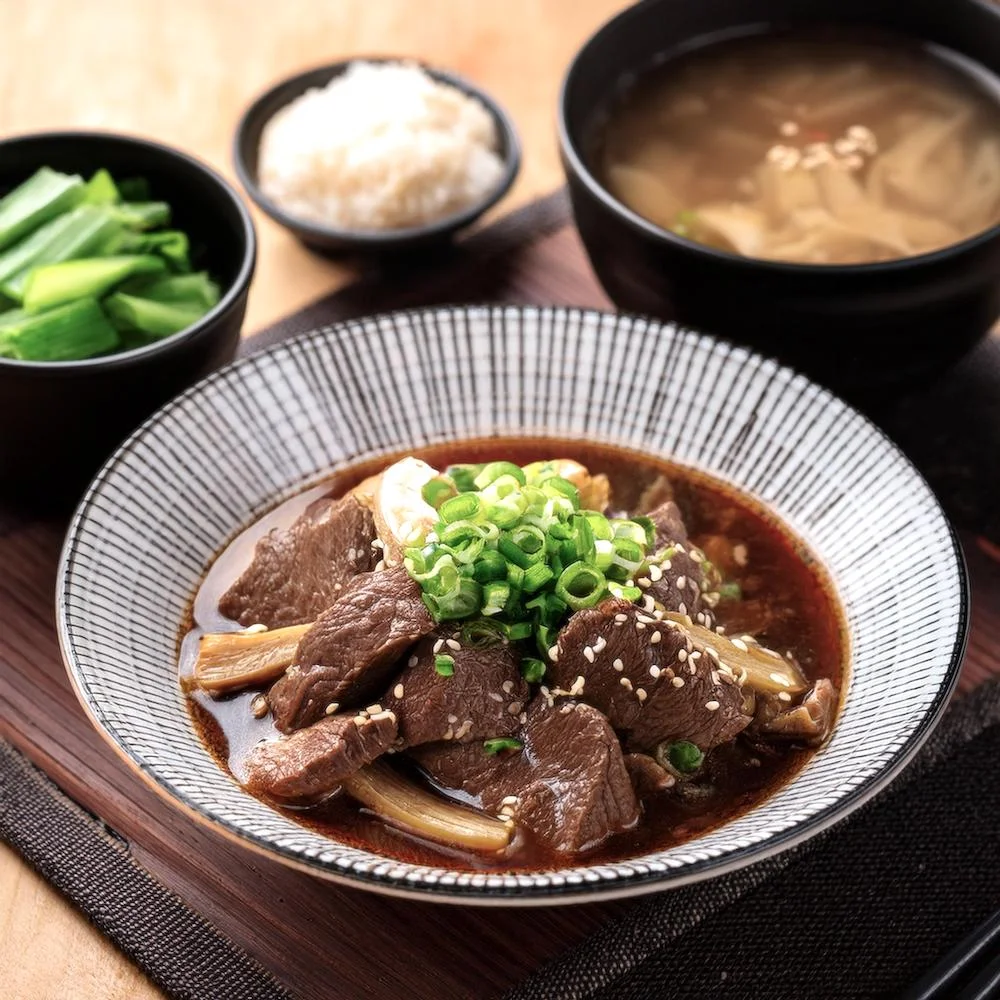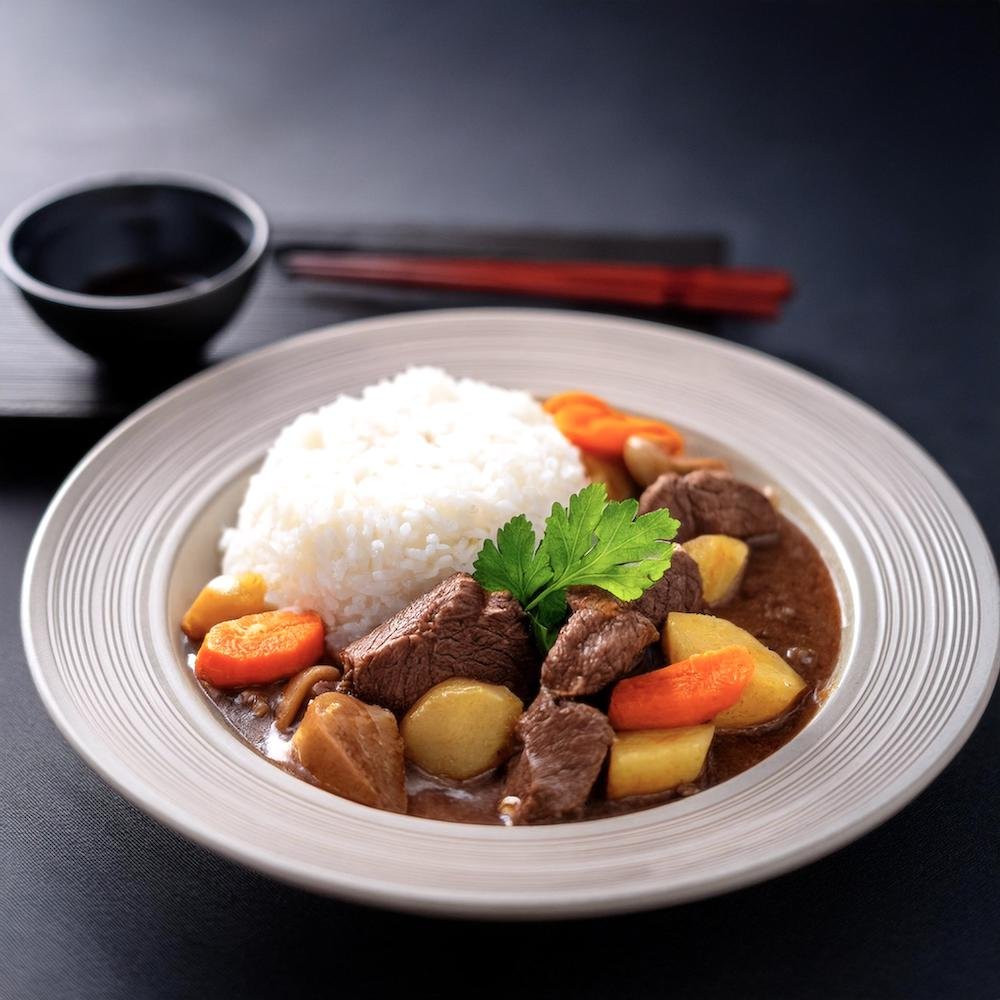Introduction
Japanese beef stew roux is a comforting dish that blends tender chunks of beef, hearty vegetables, and a rich, velvety roux-based sauce. Unlike Western-style beef stews, the Japanese version often features a slightly sweet, umami-packed flavor profile, making it a beloved comfort food in many households.
The secret to its signature taste lies in the roux—a thickened base that gives the stew its creamy texture and deep flavor. Whether you use store-bought roux cubes or make your own from scratch, mastering this dish is a rewarding culinary experience.
In this guide, we’ll dive into what makes Japanese beef stew unique, explore the ingredients, and walk you through the steps to create this delicious dish at home.
What Is Japanese Beef Stew Roux?
Japanese beef stew roux is a sauce base made from a combination of fat, flour, and seasonings. It serves as the foundation of the stew, thickening the broth and imparting a rich flavor.
1. The Role of Roux in Japanese Cuisine
What Is Roux?
- A roux is a mixture of fat (usually butter) and flour, cooked together to form a paste.
- In Japanese beef stew, the roux is often enriched with seasonings, soy sauce, and sometimes a hint of sweetness.
Why It’s Essential
- The roux adds a creamy texture and binds the ingredients, ensuring a cohesive and flavorful stew.
2. How It Differs from Western Beef Stew
Flavor Profile
- Japanese beef stew has a sweeter, more umami-forward flavor compared to the savory and herbal notes of Western stews.
- It often includes soy sauce, miso, or mirin to enhance the taste.
Thickened Consistency
- The roux creates a silky and thick sauce, as opposed to the brothier consistency of Western stews.
Preparation
- Japanese beef stew is typically simmered with roux cubes or a homemade roux, making it faster to prepare than some slow-cooked Western stews.
3. Why It’s a Comfort Food in Japan
Hearty and Satisfying
- Combining tender beef, soft vegetables, and a flavorful sauce, this stew is perfect for cold days or as a filling meal.
Versatility
- It’s a dish that can be easily customized with different vegetables, proteins, or seasonings to suit individual preferences.
Pro Tip: Use Japanese Roux Cubes for Convenience
- Pre-packaged Japanese roux cubes are a quick and reliable way to achieve authentic flavors. Look for brands like House Foods Vermont Curry Roux or S&B Golden Curry Roux in Asian grocery stores.
Key Ingredients for Japanese Beef Stew Roux

To create a flavorful and satisfying Japanese beef stew, it’s essential to choose the right ingredients. Each component plays a critical role in building the dish’s rich taste and hearty texture.
1. Beef Cuts
Recommended Cuts
- Chuck Roast: Known for its marbling, this cut becomes tender and flavorful when slow-cooked.
- Brisket: A fattier option that adds depth and richness to the stew.
- Shank or Stew Meat: Ideal for stews due to their ability to absorb flavors while becoming melt-in-your-mouth tender.
Preparation Tip
- Cut the beef into uniform chunks for even cooking. Sear them before adding to the stew for added flavor.
2. Vegetables
Classic Vegetables
- Onions: Provide sweetness and depth to the stew.
- Carrots: Add color, natural sweetness, and a hearty texture.
- Potatoes: Offer a starchy element that complements the creamy roux.
Optional Additions
- Mushrooms: Add an earthy, umami flavor.
- Daikon Radish: Lightens the dish with its mild, refreshing taste.
Preparation Tip
- Cut vegetables into larger chunks to prevent them from breaking down during cooking.
3. Japanese Roux
Store-Bought Roux Cubes
- Popular Brands: House Foods and S&B produce pre-made roux cubes that are convenient and packed with flavor.
Homemade Roux
- Ingredients: Equal parts butter and flour, with seasonings like soy sauce, ketchup, and Worcestershire sauce.
- How to Make It:
- Melt butter in a pan.
- Gradually add flour and cook until golden.
- Incorporate seasonings for a flavorful base.
Which to Choose?
- Store-bought roux cubes are quick and easy, while homemade roux allows for customization of flavors.
4. Seasonings
Must-Have Seasonings
- Soy Sauce: Adds umami and saltiness.
- Mirin: Provides subtle sweetness.
- Worcestershire Sauce: Enhances depth and complexity.
Optional Enhancements
- Red Wine: Adds richness and complements the beef.
- Miso Paste: Deepens the umami flavor for a heartier stew.
5. Broth or Stock
Base Options
- Beef Stock: Enhances the meaty flavor of the stew.
- Chicken or Vegetable Stock: Provides a lighter base while letting the roux shine.
Preparation Tip
- Use low-sodium broth if you’re adding salty seasonings like soy sauce or Worcestershire sauce.
Pro Tip: Use Fresh, High-Quality Ingredients
- Fresh vegetables and well-marbled beef cuts will elevate the overall flavor and texture of the stew.
How to Make a Japanese Beef Stew Roux

Making a Japanese beef stew roux involves a blend of preparation, cooking, and combining ingredients to create a rich and flavorful dish. Here’s a step-by-step guide to help you craft this comforting stew at home.
1. Preparing the Ingredients
1.1. Beef
- Cut the beef into bite-sized chunks, trimming excess fat if necessary.
- Season lightly with salt and pepper.
- Heat oil in a pot over medium-high heat and sear the beef until browned on all sides. Remove and set aside.
1.2. Vegetables
- Peel and cut onions, carrots, and potatoes into large, uniform chunks.
- Sauté the onions in the same pot until translucent, then add carrots and potatoes.
2. Making the Roux
Ingredients for Homemade Roux
- 3 tablespoons butter
- 3 tablespoons all-purpose flour
- 1 tablespoon soy sauce
- 1 tablespoon ketchup
- 1 teaspoon Worcestershire sauce
Steps to Make the Roux
- In a small pan, melt butter over medium heat.
- Gradually add flour, stirring continuously to form a smooth paste.
- Cook the mixture for 5–7 minutes, or until it turns a light golden color.
- Stir in soy sauce, ketchup, and Worcestershire sauce for added flavor. Remove from heat.
3. Combining the Stew
Building the Stew Base
- Return the seared beef to the pot with the sautéed vegetables.
- Add 4–5 cups of beef or vegetable stock, ensuring the ingredients are covered.
- Bring the mixture to a boil, then reduce the heat to low and simmer for 45–60 minutes, or until the beef is tender.
Incorporating the Roux
- Scoop a ladle of hot broth from the pot and gradually whisk it into the roux to thin it out.
- Stir the diluted roux back into the pot, mixing well to combine.
- Simmer the stew for an additional 10–15 minutes, allowing the roux to thicken the sauce.
4. Final Touches
Season to Taste
- Adjust salt, pepper, or soy sauce levels as needed.
- Optional: Add a splash of red wine or a teaspoon of miso paste for extra depth.
Garnish
- Serve the stew in bowls, garnished with fresh parsley or chopped green onions for a pop of color.
Pro Tip: Make It a Day Ahead
- Letting the stew rest overnight enhances the flavors, making it even more delicious when reheated.
Tips for Perfect Japanese Beef Stew Roux

Crafting the perfect Japanese beef stew roux requires attention to detail and a few tried-and-true techniques. These tips will help you achieve the best flavor, texture, and presentation for your dish.
1. Choosing the Right Beef
Recommended Cuts
- Opt for cuts like chuck roast, brisket, or shank, which become tender and flavorful when slow-cooked.
- Avoid lean cuts like sirloin, as they may dry out during simmering.
Pro Tip
- Marinate the beef with soy sauce and a touch of sake for 30 minutes before cooking to enhance its umami flavor.
2. Perfecting the Roux Consistency
Golden Rule
- Cook the roux slowly and evenly to avoid burning. A golden-brown roux will add depth and richness to the stew.
Avoid Clumps
- Whisk the roux thoroughly when adding hot broth to ensure it dissolves evenly into the stew.
Pro Tip
- For a smoother consistency, strain the broth before adding the roux.
3. Balancing Flavors
Sweetness
- Add a teaspoon of honey or mirin for a touch of sweetness to balance the savory notes.
Umami Boost
- Enhance the depth of flavor with a teaspoon of miso paste or dashi stock.
Acidity
- A splash of red wine or a teaspoon of tomato paste can brighten the flavors and add complexity.
4. Perfecting the Vegetables
Texture
- Cut vegetables into larger chunks to prevent them from disintegrating during the long simmering process.
Timing
- Add delicate vegetables like mushrooms or daikon in the final 15–20 minutes of cooking to avoid overcooking.
5. Cooking and Simmering Tips
Low and Slow Cooking
- Simmer the stew over low heat to allow flavors to meld and the beef to become tender.
Skim the Foam
- Skim off any foam or impurities that rise to the surface during cooking for a cleaner, more polished broth.
Pro Tip
- Stir occasionally to prevent sticking and ensure even cooking.
6. Serving and Presentation
Serving Suggestions
- Serve over steamed rice for a hearty meal.
- Pair with crusty bread for a Western-inspired fusion twist.
Garnishing
- Sprinkle with chopped parsley, green onions, or toasted sesame seeds for added flavor and visual appeal.
Pro Tip: Double the Recipe for Leftovers
- Japanese beef stew roux tastes even better the next day, as the flavors continue to develop. Make extra for easy reheating or freezing.
Popular Variations of Japanese Beef Stew

Japanese beef stew is a versatile dish that lends itself to countless variations. Whether you’re looking to add a personal touch or explore regional flavors, here are some popular ways to customize this comforting classic.
1. Mushroom-Enhanced Beef Stew
How to Incorporate Mushrooms
- Add earthy mushrooms like shiitake, enoki, or oyster mushrooms during the last 20 minutes of cooking.
- Sauté the mushrooms with a touch of butter or soy sauce before adding them for extra flavor.
Flavor Benefits
- Mushrooms bring an umami boost and a chewy texture that complements the tender beef.
2. Daikon and Root Vegetable Stew
How to Add Root Vegetables
- Replace or supplement potatoes with daikon radish, turnips, or parsnips for a lighter twist.
- Cut the vegetables into chunks and add them early for a softer texture, or later for a firmer bite.
Flavor Benefits
- Daikon adds a mild, slightly sweet flavor, balancing the richness of the roux.
3. Japanese Curry Beef Stew
How to Create a Curry Twist
- Add Japanese curry roux cubes to the stew for a fusion of beef stew and curry flavors.
- Include curry-friendly vegetables like sweet potatoes and green peppers.
Flavor Benefits
- The warm spices of curry roux add depth and a touch of heat, making the dish even more comforting.
4. Wine-Infused Beef Stew
How to Add Wine
- Deglaze the pot with red wine after searing the beef for a rich and complex flavor.
- Simmer with the stew for an elegant twist reminiscent of European-style dishes.
Flavor Benefits
- Red wine enhances the beef’s natural flavors and adds a luxurious finish to the stew.
5. Vegan or Plant-Based Stew
How to Make It Vegan
- Substitute beef with plant-based protein options like seitan, tofu, or jackfruit.
- Use a vegetable broth base and a roux made with plant-based butter and flour.
Flavor Benefits
- Retains the creamy, hearty texture while accommodating dietary preferences.
6. Spicy Miso Beef Stew
How to Add Heat
- Stir in a teaspoon of chili paste (like gochujang) or red pepper flakes with the roux.
- Add a dollop of miso paste for a spicy and umami-rich depth.
Flavor Benefits
- The heat from the chili and the savory miso create a bold and exciting variation.
7. Seafood and Beef Fusion Stew
How to Combine Proteins
- Add shrimp, scallops, or clams alongside the beef during the last 10–15 minutes of cooking.
- Use dashi stock as part of the broth base to complement the seafood flavors.
Flavor Benefits
- The addition of seafood introduces a briny sweetness that pairs surprisingly well with the savory beef stew.
Pro Tip: Experiment with Regional Ingredients
- Incorporate local produce or spices to give your Japanese beef stew a unique and personal touch.
Frequently Asked Questions (FAQs)
Can you use a roux for beef stew?
Yes, a roux is an excellent thickener, commonly used in Japanese beef stew. It provides a smooth, velvety texture. Gradually whisk hot broth into the roux before adding it to the stew for best results.
Why is it called hayashi rice?
Hayashi rice, a popular Japanese dish, is named after the Western-inspired stew served over rice.
Origin: The name “Hayashi” is believed to have come from Yuteki Hayashi, a Japanese chef who introduced Western-style cooking to Japan. Another theory is that it comes from the Japanese word “hayashigohan,” meaning quickly prepared rice dishes.
Composition: Hayashi rice features a demi-glace-based beef stew with onions, mushrooms, and sometimes tomato paste, served over steamed white rice.
What is the best thickener for beef stew?
Several options can thicken beef stew, depending on the desired texture and flavor:
Roux: Adds richness and smoothness, ideal for Japanese-style stews.
Cornstarch Slurry: A mix of cornstarch and water for a clear, glossy thickened texture.
Potato Starch: Works like cornstarch but is more commonly used in Japanese cooking.
Mashed Potatoes: Blends directly into the stew for a creamy and natural thickener.
Reduction: Simmering the stew longer evaporates liquid, naturally thickening the sauce.
What is Japanese stew called?
Japanese stew is commonly referred to as “niku jaga” or “nimono,” depending on the type:
Niku Jaga: A traditional Japanese beef and potato stew with a soy sauce and mirin base.
Hayashi Rice: A Western-inspired beef stew served over rice.
Oden: A hot pot-style dish with various ingredients simmered in a light soy-based broth.
Kare Raisu (Curry Rice): While technically a curry, it’s often considered a type of stew due to its thick, hearty texture.
Suggested Internal Links:
- What Pasta Is Closest to Ditalini?
Explores pasta options that could pair well with the rich and flavorful Japanese beef stew. - What Is the Secret to Crème Brûlée?
While dessert-focused, this article complements the gourmet theme, providing insights into mastering classic recipes. - Garlic Parmesan Chicken Pasta
Offers another hearty and flavorful recipe, appealing to readers exploring rich and comforting dishes. - What Can Date Palms Be Used For?
Provides a unique ingredient exploration, complementing the Japanese stew’s versatile nature. - What Is the Best Seasoning to Put on Fish?
Explores seasoning tips that could inspire readers looking to enhance their culinary skills.
Conclusion About Beef Stew Roux Japanese
Japanese beef stew roux is a delightful dish that combines the comforting flavors of tender beef, hearty vegetables, and a rich, velvety roux. Whether you stick to the traditional recipe or experiment with variations like mushrooms, daikon, or a spicy miso twist, this stew is a versatile addition to your culinary repertoire.
By mastering the art of crafting a perfect roux and balancing the flavors with seasonings like soy sauce, mirin, and red wine, you can bring the taste of Japanese comfort food to your table. Ideal for sharing with family or friends, this dish is sure to become a favorite for cozy nights and special gatherings.
So why not give it a try? Gather your ingredients, fire up the stove, and savor the magic of Japanese beef stew roux. Happy cooking!
Discover more mouthwatering recipes on our Web Site ! Stay connected and get inspired by following us on Facebook, Instagram, Pinterest, and Twitter for the latest updates!
